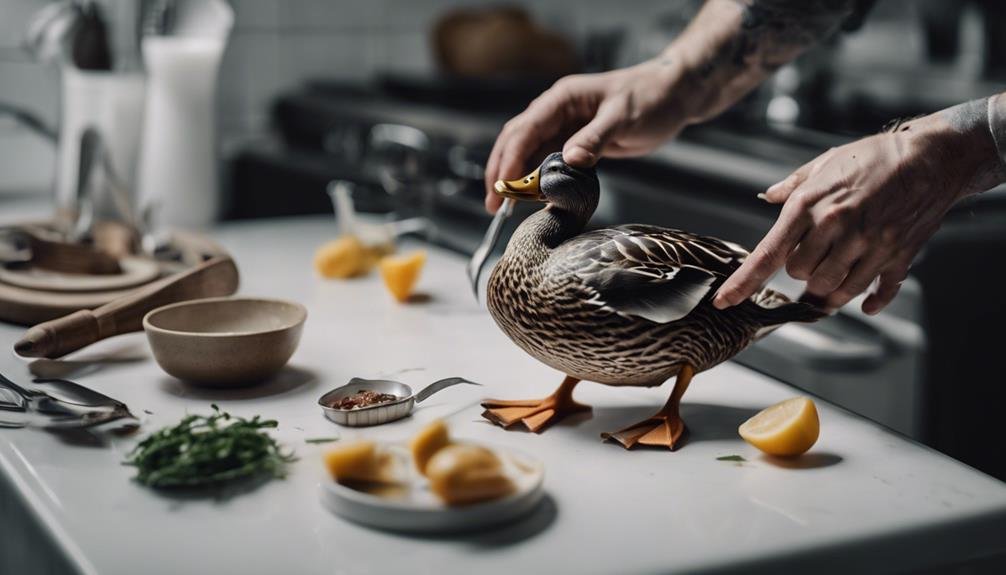To master duck deboning in minutes, start by preparing the bird by plucking feathers, exposing underlying tissue, and familiarizing yourself with the skeletal structure. Use a sharp, thin-bladed knife to make a precise initial incision, and then free the breasts and tenderloins by cutting around the ribcage and gently teasing the meat away from the bone. Remove the ribcage and sternum, and then debone the wings and legs by targeting the joints. Maintain a clean and organized workspace, and store the deboned meat properly to guarantee food safety. Follow these steps to achieve a clean, boneless duck, and explore further to refine your deboning skills.
Key Takeaways
- Use a sharp, sturdy knife with a 3-4 inch blade to efficiently debone the duck.
- Familiarize yourself with the duck's skeletal structure to better navigate the deboning process.
- Make a clean, gentle incision with a thin-bladed knife, applying gentle, consistent pressure.
- Remove the ribcage and sternum by cutting through cartilage and ligaments, working from the bottom up.
- Keep the workspace clean and organized to prevent contamination and promote efficiency.
Essential Deboning Tools Needed
You'll need a sharp, sturdy knife, preferably with a 3-4 inch blade, to efficiently dissect the duck's body and extract its meat without tearing or damaging the surrounding tissue. A high-quality deboning knife is essential for this task. Regular Sharpener maintenance is vital to maintain the knife's edge and prevent accidents. A clean and stable Cutting board is also necessary to prevent contamination and facilitate a smooth deboning process. Additionally, having Cleaning essentials like soap, hot water, and paper towels on hand will guarantee a sanitary environment. With these essential tools, you'll be well-equipped to tackle the deboning process with confidence and precision.
Preparing the Duck for Deboning
With your deboning tools at the ready, the next step is to prepare the duck for the deboning process, which begins with plucking the bird to expose the skin and underlying tissue. This essential step requires attention to detail and a basic understanding of duck anatomy.
To effectively prepare the duck, remember:
- Plucking techniques involve gentle yet firm pulls to avoid tearing the skin.
- Remove feathers from the breast, belly, and back, taking care not to puncture the skin.
- Expose the underlying tissue, including the keel bone, breastbone, and ribcage.
- Take note of the duck's natural seams, such as the wishbone and shoulder joints, which will aid in the deboning process.
- Familiarize yourself with the duck's skeletal structure to better navigate the deboning process.
Making the Initial Incision
The initial incision, a key step in deboning a duck, involves making a precise cut at the back of the neck, just above the base of the skull, to access the underlying tissue and bones. To achieve a clean cut, select a sharp, thin-bladed knife, ideally 4-6 inches in length. Hold the knife at a 45-degree angle, with the blade facing the direction you want the incision to follow. Apply gentle, consistent pressure, using a gentle sawing motion to make the cut. Avoid applying too much pressure, which can cause the knife to slip and damage surrounding tissue. Proper cutting techniques are essential to making a clean, efficient incision, setting the stage for a successful deboning process.
Freeing the Breasts and Tenderloins
One essential aspect of deboning a duck is freeing the breasts and tenderloins from the ribcage, sternum, and collarbone, which requires careful manipulation of the bird's internal structures. To achieve this, it's vital to understand the breast anatomy and locate the tenderloins, which are nestled beneath the breast muscles.
Identify the keel bone, which separates the breast muscles, and gently pry them apart to access the tenderloins.
Use a sharp knife to carefully cut around the ribcage, taking care not to puncture the breast meat.
Gently tease the tenderloins away from the ribcage, working from the center outwards.
Use your fingers or a blunt instrument to carefully separate the breast meat from the ribcage.
Take your time and work patiently to avoid damaging the delicate meat.
Removing the Ribcage and Sternum
Once the tenderloins are freed, attention turns to removing the ribcage and sternum, a crucial step in deboning the duck that requires precision and care to avoid damaging the surrounding meat. To begin Ribcage Removal, locate the ribcage and identify the connection points between the ribs and the spine. Using a sharp knife, carefully cut through the cartilage and ligaments, working from the bottom up. Continue to separate the ribcage from the spine, taking care not to puncture the surrounding meat. Next, focus on Sternum Separation, cutting through the breastbone to release the ribcage from the sternum. With the ribcage and sternum removed, you'll have clear access to the remaining meat, bringing you one step closer to deboning mastery.
Deboning the Wings and Legs
With the ribcage and sternum removed, attention shifts to the wings and legs, where a precise dissection of the joints and tendons is required to free the meat from the skeletal structure. This stage demands a thorough understanding of wing anatomy and leg quartering to avoid damaging the surrounding meat.
- Identify the wing's humerus, radius, and ulna bones to locate the joints.
- Cut through the joint capsules to release the wings from the body.
- Repeat the process for the legs, targeting the femur, patella, and tibia.
- Gently pry the meat away from the bones, taking care not to tear or puncture the skin.
- Continue to work methodically, freeing the meat from the skeletal structure to achieve a clean, boneless duck.
Tips for Efficient Deboning
To debone a duck efficiently, grasp the bird firmly and make deliberate, calculated cuts to minimize waste and maximize meat retrieval. For deboning beginners, having a clean and organized workspace is crucial to avoid confusion and mistakes.
| Deboning Tip | Why It Matters |
|---|---|
| Use sharp knives | Reduces effort and prevents tearing meat |
| Remove feathers before deboning | Easier to clean and handle the bird |
| Keep the workspace clean | Prevents contamination and promotes efficiency |
When traveling with deboned duck, consider these travel tips: pack the meat in airtight containers, keep it cool, and label the contents. By following these tips, you'll be well on your way to deboning mastery, ensuring you can enjoy your duck anywhere, anytime.
Post-Deboning Care and Storage
After deboning, properly caring for and storing the meat is essential to maintaining its quality and safety. Improper storage can lead to contamination, spoilage, and reduced meat shelflife. To avoid this, follow these essential steps:
- Proper wrapping: Wrap the deboned meat tightly in plastic wrap or aluminum foil to prevent air exposure.
- Label and date: Label the wrapped meat with the date and contents to facilitate easy identification.
- Freezer organization: Store the wrapped meat in a well-organized freezer to prevent cross-contamination and guarantee easy access.
- Temperature control: Maintain a consistent freezer temperature of 0°F (-18°C) or below to preserve meat quality.
- Use within a reasonable timeframe: Consume the stored meat within a few months to maintain peak flavor and texture.
Frequently Asked Questions
Can I Debone a Duck in the Field, or Should I Wait Until I Get Home?
When considering deboning a duck, evaluate field conditions and timing considerations. If conditions are unsanitary or time is limited, wait until returning home to guarantee a clean and efficient deboning process, prioritizing meat quality and safety.
Do I Need to Refrigerate the Deboned Duck Immediately After Processing?
As the clock ticks, bacterial growth accelerates; it's vital to refrigerate the deboned duck immediately to safeguard meat safety, proper cooler logistics, and prevent spoilage, making it a priority over convenience.
How Do I Prevent Contamination While Deboning a Duck?
To prevent contamination while deboning a duck, maintain a clean workspace and utilize sanitized tools to minimize bacterial transfer, ensuring a safe and hygienic processing environment.
Can I Debone a Duck With a Dull Knife, or Is a Sharp One Necessary?
'Dull knives dull skills, risking ripped flesh and contaminated meat. Precision deboning demands a sharp, surgical blade, wielded with deliberate cutting technique to facilitate swift, sanitary separation of tender meat from skeletal anchors.'
Are There Any Specific Regulations for Transporting Deboned Ducks Across State Lines?
When transporting deboned ducks across state lines, guarantee compliance with federal and state regulations, obtaining necessary Interstate Permits, and prepare for Border Inspections, as failure to comply can result in fines, penalties, or even confiscation of the game.
Conclusion
Mastering duck deboning is an essential skill for waterfowl hunters, allowing for efficient transportation and storage of harvested meat. By following the outlined steps, hunters can quickly and effectively debone a duck, ensuring a successful hunting trip. Finally, for example, a hunter in Louisiana deboned a harvested mallard in under 10 minutes, resulting in 1.5 pounds of usable breast meat, highlighting the effectiveness of this skill.









